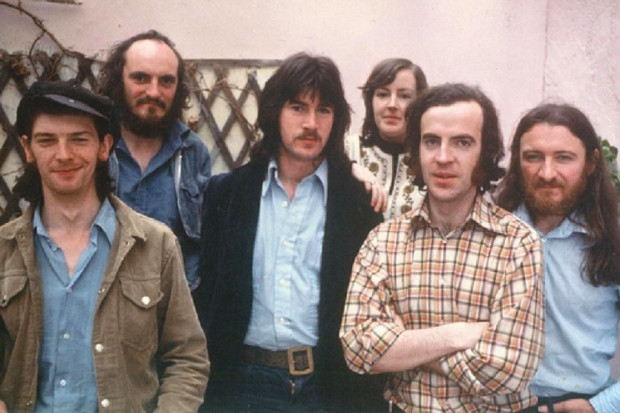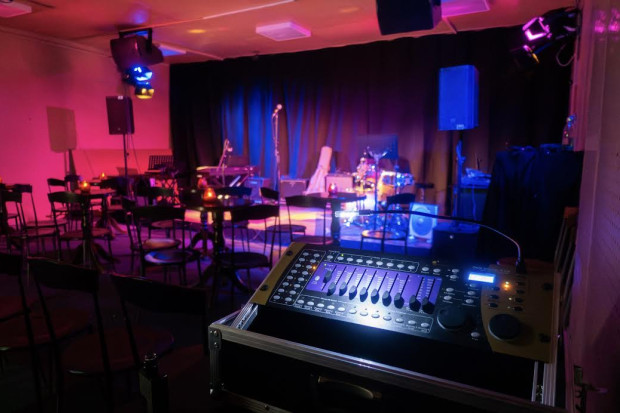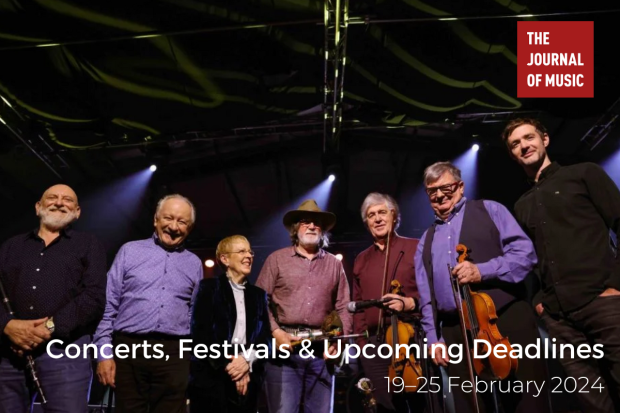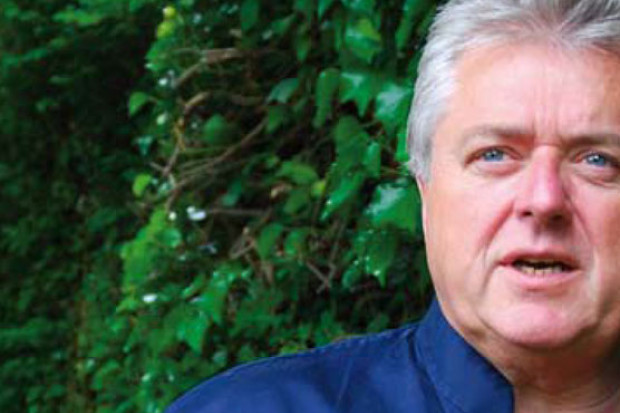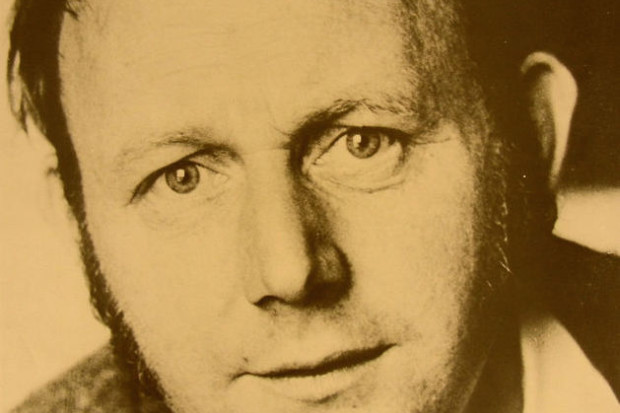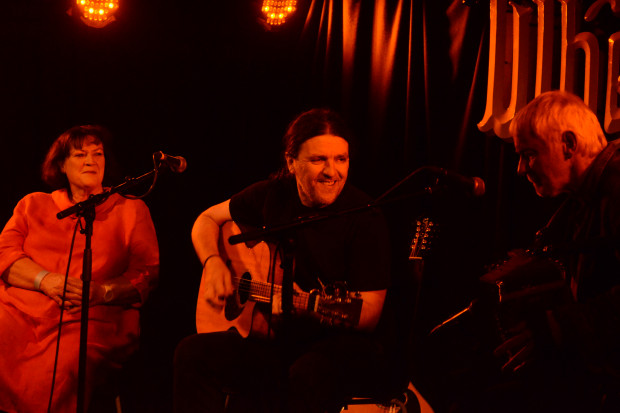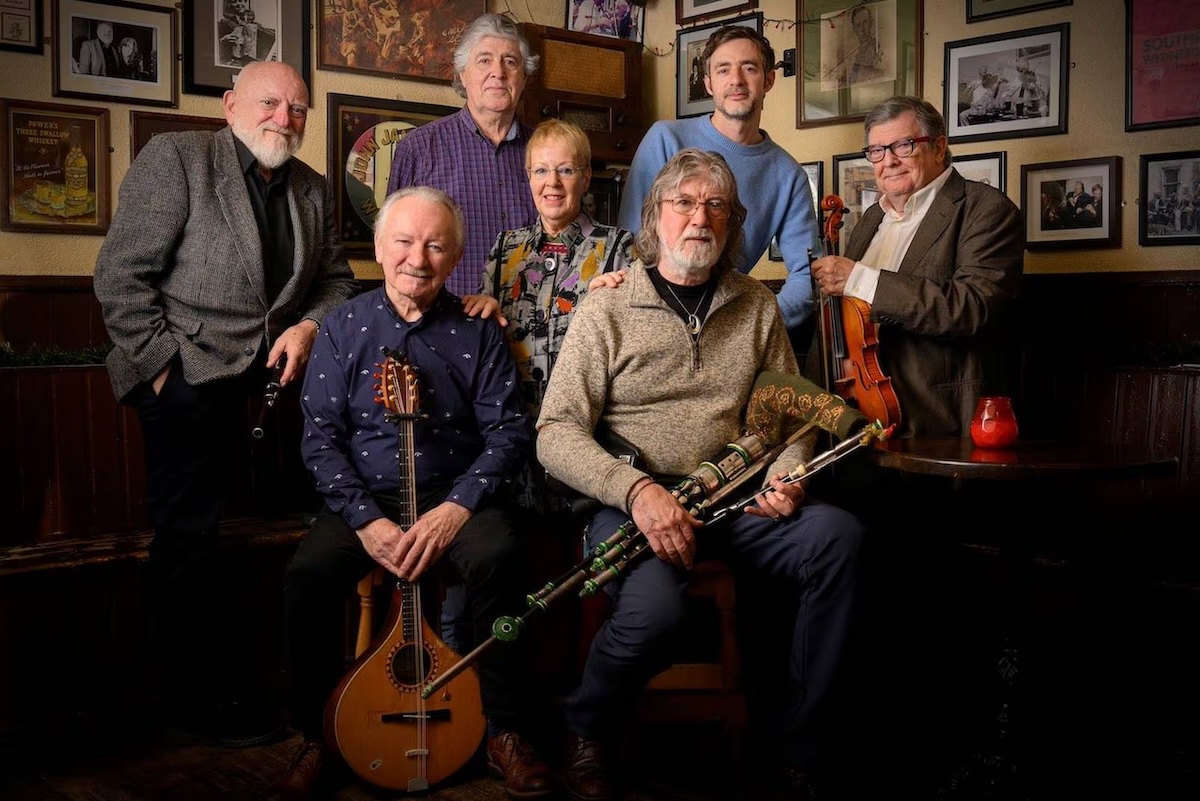
The reformed Bothy Band: Matt Molloy, Dónal Lunny, Paddy Glackin, Tríona Ní Dhomhnaill, Paddy Keenan, Seán Óg Graham and Kevin Burke.
The Return of the Bothy Band
The Bothy Band, active for around five years in the 1970s, produced performances and recordings that were (and still remain) exciting and electrifying, as well as being meticulously structured and arranged. Famous for the abandon and unrestraint of their tune playing, and the power and rhythmic propulsion of the backing, the group’s music was simultaneously intricately textured, exploiting to the full the potential of having three melody players (who were also some of the greatest exponents of these instruments) balanced by three different accompaniment instruments with contrasting styles (who were also renowned exponents). And although famed for their then wild appearance and behaviour, the group’s songs and slower tunes were expressive and affecting. Widely regarded as the archetypal revival band, The Bothy Band became a model and template for later groups, and a benchmark by which others are measured against.
The 90-minute film An Bothy Band, broadcast last weekend (31 March) on TG4, documents the band’s reunion for a concert (which has since been extended into a tour). Made by Big Mountain Productions, as part of the BAI Sound and Vision Scheme, and directed by Garry Keane, the film is structured in two parts. The first centres on the band’s rehearsals in the picturesque setting of Cabinteely House, a sequence fleshed out with generous interviews and archive material. The second consists of a concert held in the Complex in Dublin that was staged ‘in the round’ with a select audience, complemented by sparser commentary both on and off-stage. For this reunion, seven musicians are involved (all of the albums were recorded with a line-up of six players). Four have been with the band throughout its existence: Tríona Ní Dhomhnaill (clavinet and vocals), Matt Molloy (flute), Paddy Keenan (pipes) and Dónal Lunny (bouzouki). Two of the band’s fiddlers over the years take part: Kevin Burke, who replaced Tommy Peoples from the second album onwards, and Paddy Glackin, who was with the group from the outset, yet left before the first album was recorded. Joining the band on guitar is Seán Óg Graham, in place of Mícheál Ó Domhnaill, who passed away in 2006.
Reunions
The opening subtitles (and some of the interviews) include a sleight of hand: it’s not really true that the band are coming back together for the first time in fifty years; they appeared at two Gradam Ceoil concerts broadcast on TG4 itself (in 1999 and 2002), and also played in Vicar Street in 2007 for a one-off concert to mark the passing of Mícheál Ó Domhnaill. Perhaps this should alert the viewer that, as with any ‘heritage’ performance, events such as this are always self-affirming in establishing their place in the canon and in their myth-making: it is more romantic to believe in a mystical communion half a century on than to see this as a more polished and carefully curated revival. Further fuel for this is the gambit that they have only six days to practice for this special live concert, which may stem from Big Mountain Productions’ background in reality TV.
The documentary portion of the film is – some staginess aside – valuable for the insights it gives into the inner workings of the band. We see the musicians working out parts, discussing specific speeds in beats per minute, reflecting on the rehearsals, as well as using charts and other notes detailing the arrangements. What emerges from these clips, and the interviews with band members, was the leading role that Dónal Lunny took in the arranging process. Kevin Burke and Paddy Keenan comment on how he could strengthen a tune, and that he was the key to the band’s success. Lunny himself recalls how he ‘began to hear the potential for … an alternative approach to the chording … or to the harmony … and it became a way of thinking about the music’. Both him and the band emphasise how central Mícheál Ó Domhnaill was in shaping the arrangements, as well as for his singing. Lunny also singles out Tríona Ní Dhomhnaill as playing a crucial role as ‘the third member of the rhythm section’ and as ‘the bass player’.
One particularly fascinating rehearsal clip shows the musicians listening to their own recording of ‘Rip the Calico’, a set comprising a jig and five reels from the third album, Out of the Wind, Into the Sun, and trying to recall the combination of riffs they played during ‘The Enchanted Lady’. For me, this track perfected their approach of building up a set and a texture with different rhythmic riffs, and it’s a pity that it wasn’t included in the concert film (those sharp-eyed will have spotted it towards the bottom of the set list they showed). More notably, the clip underscores that the processes here are geared towards the recreation of these celebrated tracks, and aim to replicate as closely as possible the Urtexts of the 1970s.
‘Rip the Calico’ is one of many sets that led to them being compared to rock music, and indeed one of the first comments in the film is ‘Rac ‘n’ roll a bhí ann’ (‘It was rock ‘n’ roll’). While some of the interview segments are worthwhile and deliver the sort of oral history that often enlivens biographical documentaries, a fair amount of it is also repetitive – particularly the segments commenting on the band’s rock-music approach, the excitement of the music and performances, and the potential thrill of reliving this. A closer look at the credits also reveals that some of the commentators were also involved in making the programme – one would imagine that there were enough musicians and traditional music sages that could have contributed here without resorting to tacitly including those involved in its production. There are heartfelt portraits of former members Tommy Peoples and Mícheál Ó Domhnaill, and their loss is obviously still sharply felt by the band. Perhaps because of the hagiographic tone, some of the contextualisation in the opening section of the film is lacking – those looking for a more investigative documentary will be disappointed. For instance, it’s not explained why Glackin left the band (or indeed how he was brought back into the fold for the reunion); how and why Tommy Peoples joined is unexplored; and there is little said about the sudden breakup of the band, and why this reunion happened
Full sets
The final part of the film moves to the Complex for the concert. There are full and uninterrupted sets, which is a welcome decision, and the camerawork and sound are excellent. Perhaps the large 1970s portraits of the band in the background are an unnecessary component, and possibly risk weighing down the performance with further expectations of recapturing the past. Thankfully the band are on excellent form throughout, with Seán Óg Graham fitting in perfectly with the original members. The audience responds enthusiastically to key moments in ‘The Salamanca’, ‘The Kesh Jig’, and ‘Farewell to Erin’, the latter featuring fine work from Kevin Burke. The fruits of the careful rehearsal are evident on ‘The Pipe on the Hob’, which although a little slower, faithfully reproduces the detailed harmony parts towards the end of the set. Tríona Ní Dhomhnaill excels throughout, particularly in ‘Pretty Peg’, and is joined for the iconic ‘Do You Love an Apple’ by her sister Maighread. Oddly enough the bulk of the concert is taken from the first album, with only two sets each from Old Hag You Have Killed Me and Out of the Wind, Into the Sun – one of these, ‘The Maids of Mitchelstown’, is one of their most striking arrangements, slowing the reel down and garlanding it with beautifully crafted countermelodies. The final set, ‘The Green Groves of Erin’ and ‘The Flowers of Red Hill’, shows that Molloy and the fiddlers have lost none of their precision and attack, the band’s playing recapturing the bite and rhythm of the original.
This facet of the reunion – the opportunity of getting to (re)experience the original – has generated a tremendous response among audiences, online and in sold-out tours. And yet in another sense for many of us this music is pre-digested – we are listening for how the performance meets our own aural image of the band’s recordings. Arguably we don’t have to really listen – we know exactly what is going to happen (and our enjoyment stems from our experience of this, and for the meeting of our expectations). Although at times during the concert, the depth of playing and singing does exceed our expectations; this is most evident on ‘The Maid of Coolmore’, where the arrangement departs significantly from the original.
Elsewhere in the documentary portion of the film, Tríona Ní Dhomhnaill highlights the originality of the band, saying that ‘everything was new and everything was magical’: many of the tunes, and how they were presented, were totally novel both for her, and obviously also for audiences (as Doireann Ní Bhriain and others on the film attest to). This is turned on its head for the band’s reunion: now almost nothing is new, and possibly nothing can be allowed to be new; everything has to be more than just familiar, it has to be exactly as it was the first time around – this is what produces the magic, the sense of recapturing lightning, the recreating of the spark of the performances and recordings of the 1970s, something adverted to several times by the post-show commentators. And although former manager Fachtna Ó Ceallaigh says that he wants to hear the Bothy Band as they are now – which of course is true – the music’s success, and the audience’s response to it, depends on it being an embodiment of the spirit of the 1970s, a conduit for the audience to recover their experience of it, or (for those of us not old enough to remember it) to imagine ourselves there.
None of this is to say that there isn’t satisfaction for both the band (as was patently clear from the film) or for audiences – I’m looking forward to seeing them later this year as well! But it does raise questions about the degree to which aspects of the tradition are moving towards the form of heritage rock and pop that is so commonplace in popular culture. Obviously a tradition depends on maintaining, honouring and reanimating the music and the performers of its past, but to over-emphasise this risks such endeavours becoming more about creating and reinforcing canons, about myth-making, and the industry of nostalgia (both real and imagined). Maybe this is over-cautionary, and I am torn between the two positions here: there is in essence nothing wrong with yielding to the attractions and charms of nostalgia – as the end of the film showed, the emotions it yielded for the performers were real and profound. It would be churlish to suggest that musicians cannot or should not revisit the music of their past, and many younger musicians and listeners too will benefit from being able to hear this music in a live setting. However, in the case of this film, as with the Planxty reunion, the live performances of Andy Irvine and Paul Brady, the Ceoltóirí Chualann revivals on Seán Ó Riada anniversaries, even aspects of the Drawing from the Well series, it stands as a challenge to the traditional music community to reflect on these revivals, and to always try to reach beyond the canon also, just as the Bothy Band did.
To view An Bothy Band, visit www.tg4.ie.
Subscribe to our newsletter.
Published on 4 April 2024
Adrian Scahill is a lecturer in traditional music at Maynooth University.










